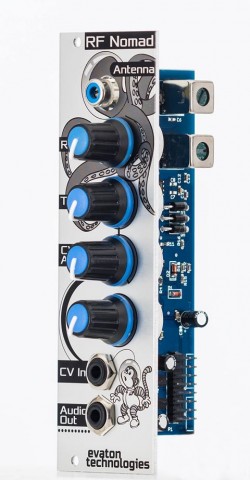 Evaton Technologies has released the RF Nomad Voltage Controlled Shortwave Receiver – a new Eurorack synthesizer module.
Evaton Technologies has released the RF Nomad Voltage Controlled Shortwave Receiver – a new Eurorack synthesizer module.
Here’s what they have to say about it:
Hissy interstation audio. Squealy heterodynes. Fading stations. Atmospheric noises. Faint voices in foreign languages from distant broadcast stations. Fire and brimstone. It’s all in there, just like your granddad’s old tabletop shortwave.
But, the RF Nomad adds a twist: The tuning is voltage controlled. Sure, when you were a kid, you discovered you could make spacy noises on Papa’s shortwave by slowly turning the tuning dial.
But just how fast could you twist that dial? Faster than an audio-rate LFO? Hardly. Voltage controlled tuning means that the RF Nomad will let you explore sounds you never imagined you could get out of a shortwave receiver.
RF Nomad Voltage Controlled Shortwave Receiver
The RF Nomad is a voltage controlled shortwave receiver, tuning the 31 meter shortwave band. A bipolar control voltage input offsets the main tuning knob, allowing an external CV source to ramp tuning up and down from DC to audio rates.
The RF Nomad adds the squealy, squelchy, noisy, unpredictable vintage sounds of shortwave radio to your modular. According to the developer, it’s been designed to be extra noisy, extra squealy, extra gritty, and just downright nasty.
No built-in output filtering means that a rich spectrum of harmonic content is available on the audio output jack. Audio levels can be driven to distortion. CV control lets you add your own creative spin on sound design.
The RF Nomad Voltage Controlled Shortwave Receiver is available now, priced at US $176. See the Evaton site for details.

I’ve done some videos with this module. Great fun my YouTube is http://www.youtube.com/flux302
Here’s his RF Nomad video. https://www.youtube.com/watch?v=MIR7sHCSIiY&list=UUN7g1DMN-RDjJfkqW6BZRFA
What an excellent idea – there are ephemeral sound sources all around us … and then there’s this!!
I so want this. I’m going to start looking for a eurorack box right away!
Oh my, that looks fun.
So basically you can now accomplish bleepy annoying “music” with just one module instead of 9+U.
you get modular!
What a cool idea. The modular world is really taking off these days.
This seems a cool module. If I were them, I’d have been tempted to add switchable output filtering, for ease of use, though. I also think it’d be cool if they released as a sort of companion module a low-power eurorack shortwave transmitter, so you could transmit your own audio signal, and then tune into it as a station on this module. If you did it as a multi-channel job, with different inputs transmitted at different frequencies, you could use it as a really weird and funky cross-fader, or something.
That is a stellar idea. I like the way you think. I hope someone from Evaton Technologies reads is paying attention.
I desperately want to run the output to a mult and send it back into the tuner CV….
I used to sample Russian shortwave broadcasts (recording in Texas) for some crazy background radio stuff, if I had a Euro setup I would be all over this.
Enjoy it while it lasts…
While what lasts?
I assumed he meant while people are still making shortwave transmissions. The Internet must be affecting short wave radio.
The Internet has no effect whatsoever on Shortwave and HAM culture. They are just as if not more prevalent today than ever. Especially as it is seen as a way of communicating beyond the spying eyes of the government. Data can be transmitted encrypted as fast or faster than the fastest Internet connection.
One thing the article does not indicate is the importance of the antenna. Shortwave requires more than a couple of feet of lead line on that RCA socket. You would best investigate if you can put up an antenna tower in your back yard, or perhaps string a large loop array in your attic. Shortwave is fidgety and is only attracted to the most admirable of antennae, fashioned with care, festooned with wit, and positioned with alacrity..
Great module! When I first started experimenting with sound I used to use my old radio as a noise source. At the bottom end of the LW band there’s a strange signal that broadcasts a very faint pattern of beeps, and they sound great through a delay chain.